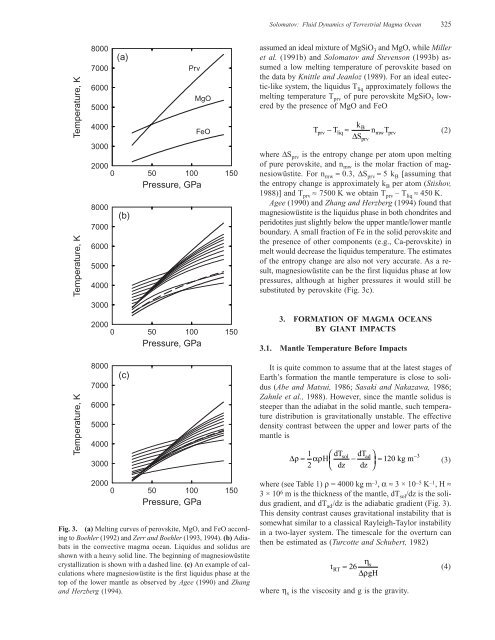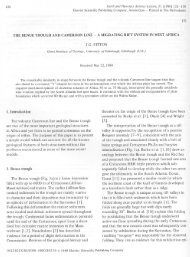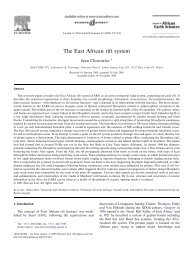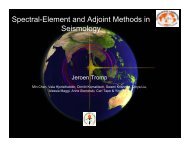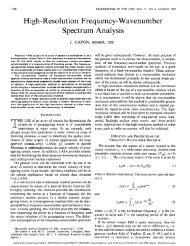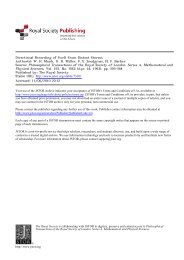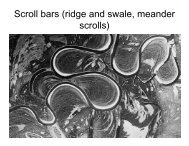Fluid Dynamics of a Terrestrial Magma Ocean - NMSU Geophysics ...
Fluid Dynamics of a Terrestrial Magma Ocean - NMSU Geophysics ...
Fluid Dynamics of a Terrestrial Magma Ocean - NMSU Geophysics ...
You also want an ePaper? Increase the reach of your titles
YUMPU automatically turns print PDFs into web optimized ePapers that Google loves.
Solomatov: <strong>Fluid</strong> <strong>Dynamics</strong> <strong>of</strong> <strong>Terrestrial</strong> <strong>Magma</strong> <strong>Ocean</strong> 325Temperature, KTemperature, K80007000600050004000300020000 50 100 150Pressure, GPa800070006000500040003000(a)(b)PrvMgOFeO20000 50 100 150Pressure, GPaassumed an ideal mixture <strong>of</strong> MgSiO 3 and MgO, while Milleret al. (1991b) and Solomatov and Stevenson (1993b) assumeda low melting temperature <strong>of</strong> perovskite based onthe data by Knittle and Jeanloz (1989). For an ideal eutectic-likesystem, the liquidus T liq approximately follows themelting temperature T prv <strong>of</strong> pure perovskite MgSiO 3 loweredby the presence <strong>of</strong> MgO and FeOTprvkB−Tliq≈ nmwTprv(2)∆ Swhere ∆S prv is the entropy change per atom upon melting<strong>of</strong> pure perovskite, and n mw is the molar fraction <strong>of</strong> magnesiowüstite.For n mw ≈ 0.3, ∆S prv ≈ 5 k B [assuming thatthe entropy change is approximately k B per atom (Stishov,1988)] and T prv ≈ 7500 K we obtain T prv – T liq ≈ 450 K.Agee (1990) and Zhang and Herzberg (1994) found thatmagnesiowüstite is the liquidus phase in both chondrites andperidotites just slightly below the upper mantle/lower mantleboundary. A small fraction <strong>of</strong> Fe in the solid perovskite andthe presence <strong>of</strong> other components (e.g., Ca-perovskite) inmelt would decrease the liquidus temperature. The estimates<strong>of</strong> the entropy change are also not very accurate. As a result,magnesiowüstite can be the first liquidus phase at lowpressures, although at higher pressures it would still besubstituted by perovskite (Fig. 3c).3. FORMATION OF MAGMA OCEANSBY GIANT IMPACTSprv3.1. Mantle Temperature Before ImpactsTemperature, K800070006000500040003000(c)It is quite common to assume that at the latest stages <strong>of</strong>Earth’s formation the mantle temperature is close to solidus(Abe and Matsui, 1986; Sasaki and Nakazawa, 1986;Zahnle et al., 1988). However, since the mantle solidus issteeper than the adiabat in the solid mantle, such temperaturedistribution is gravitationally unstable. The effectivedensity contrast between the upper and lower parts <strong>of</strong> themantle is1−∆ρ ≈ αρH dT sol dTad− ≈ 120 kg m 32 dz dz(3)20000 50 100 150Pressure, GPaFig. 3. (a) Melting curves <strong>of</strong> perovskite, MgO, and FeO accordingto Boehler (1992) and Zerr and Boehler (1993, 1994). (b) Adiabatsin the convective magma ocean. Liquidus and solidus areshown with a heavy solid line. The beginning <strong>of</strong> magnesiowüstitecrystallization is shown with a dashed line. (c) An example <strong>of</strong> calculationswhere magnesiowüstite is the first liquidus phase at thetop <strong>of</strong> the lower mantle as observed by Agee (1990) and Zhangand Herzberg (1994).where (see Table 1) ρ = 4000 kg m –3 , α ≈ 3 × 10 –5 K –1 , H ≈3 × 10 6 m is the thickness <strong>of</strong> the mantle, dT sol /dz is the solidusgradient, and dT ad /dz is the adiabatic gradient (Fig. 3).This density contrast causes gravitational instability that issomewhat similar to a classical Rayleigh-Taylor instabilityin a two-layer system. The timescale for the overturn canthen be estimated as (Turcotte and Schubert, 1982)tRT≈ 26 η s∆ρgHwhere η s is the viscosity and g is the gravity.(4)


